Developing a Math Unit Plan: Stage 3 Numbers and Algebra, Year 5-6
VerifiedAdded on 2023/01/12
|23
|2818
|33
Project
AI Summary
This document outlines a comprehensive unit plan for teaching whole numbers and algebraic concepts to Year 5 and 6 students (Stage 3) aligned with the NSW Mathematics K-10 Syllabus. The unit, which spans eight lessons, focuses on developing students' understanding of place value, comparison of whole numbers, factors, multiples, Highest Common Factor (HCF), and Lowest Common Multiple (LCM). The plan incorporates a variety of learning experiences, including quantifying numbers, place value patterns, and the application of number theory to problem-solving. Each lesson includes specific syllabus content, learning activities, resources, and assessment strategies. A summative assessment task, involving an overhead spinner activity, is designed to evaluate students' comprehension of these concepts. Furthermore, the unit includes a detailed unit overview, problem-based lessons, and a marking rubric aligned with the NESA Common Grade Scale to assess student performance and skills development, demonstrating alignment with the Australian Professional Standards for Teachers.
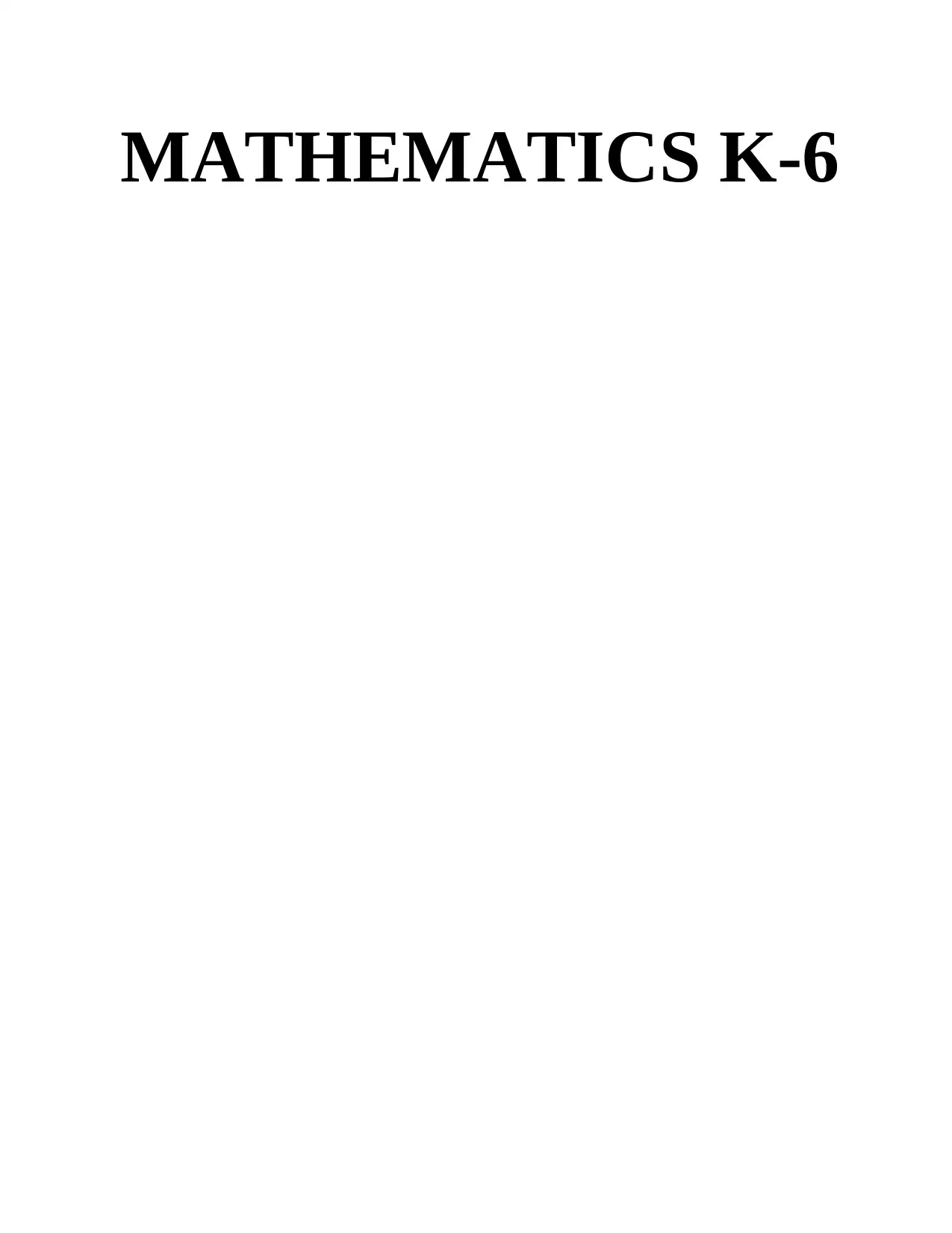
MATHEMATICS K-6
Paraphrase This Document
Need a fresh take? Get an instant paraphrase of this document with our AI Paraphraser

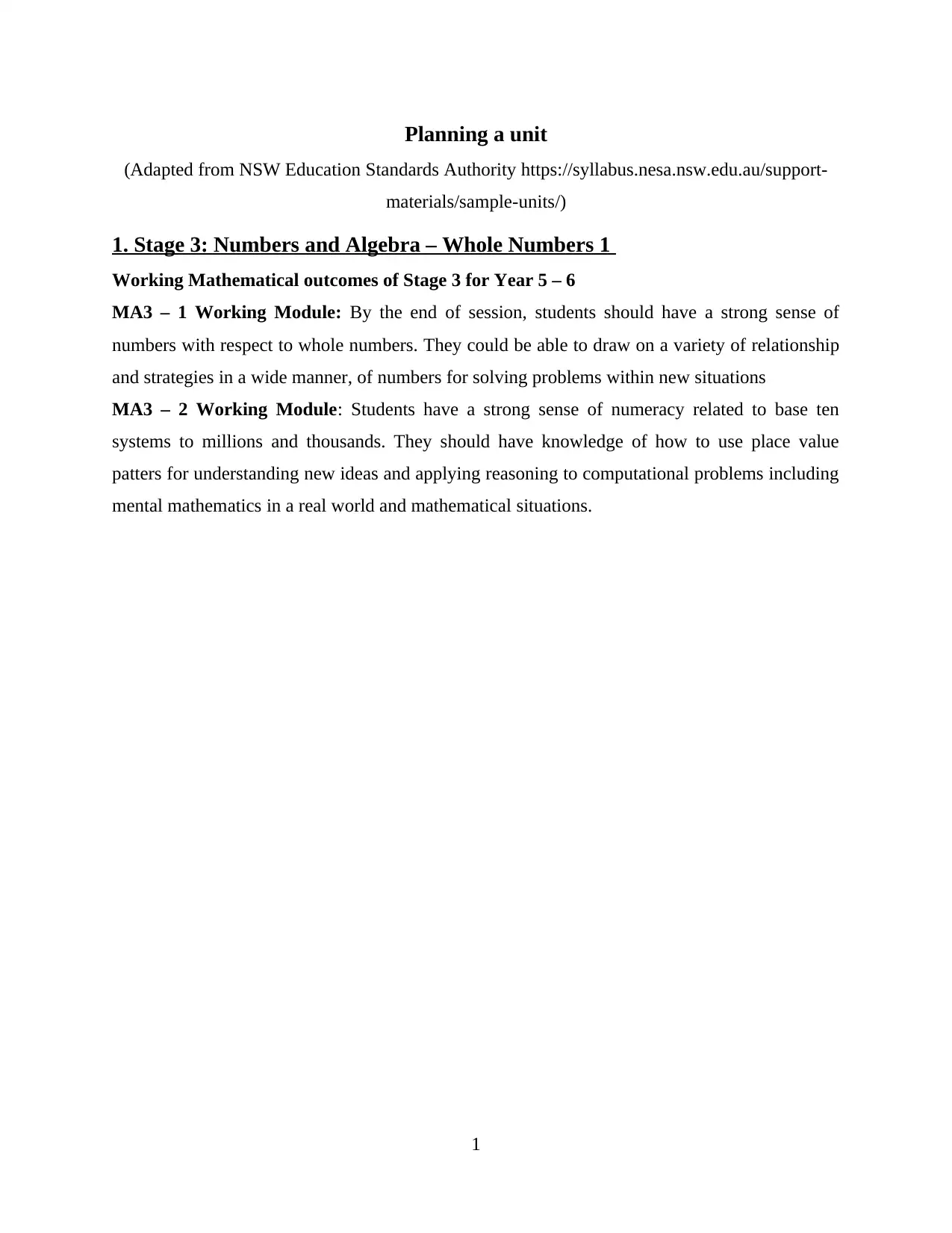
Planning a unit
(Adapted from NSW Education Standards Authority https://syllabus.nesa.nsw.edu.au/support-
materials/sample-units/)
1. Stage 3: Numbers and Algebra – Whole Numbers 1
Working Mathematical outcomes of Stage 3 for Year 5 – 6
MA3 – 1 Working Module: By the end of session, students should have a strong sense of
numbers with respect to whole numbers. They could be able to draw on a variety of relationship
and strategies in a wide manner, of numbers for solving problems within new situations
MA3 – 2 Working Module: Students have a strong sense of numeracy related to base ten
systems to millions and thousands. They should have knowledge of how to use place value
patters for understanding new ideas and applying reasoning to computational problems including
mental mathematics in a real world and mathematical situations.
1
(Adapted from NSW Education Standards Authority https://syllabus.nesa.nsw.edu.au/support-
materials/sample-units/)
1. Stage 3: Numbers and Algebra – Whole Numbers 1
Working Mathematical outcomes of Stage 3 for Year 5 – 6
MA3 – 1 Working Module: By the end of session, students should have a strong sense of
numbers with respect to whole numbers. They could be able to draw on a variety of relationship
and strategies in a wide manner, of numbers for solving problems within new situations
MA3 – 2 Working Module: Students have a strong sense of numeracy related to base ten
systems to millions and thousands. They should have knowledge of how to use place value
patters for understanding new ideas and applying reasoning to computational problems including
mental mathematics in a real world and mathematical situations.
1
⊘ This is a preview!⊘
Do you want full access?
Subscribe today to unlock all pages.

Trusted by 1+ million students worldwide
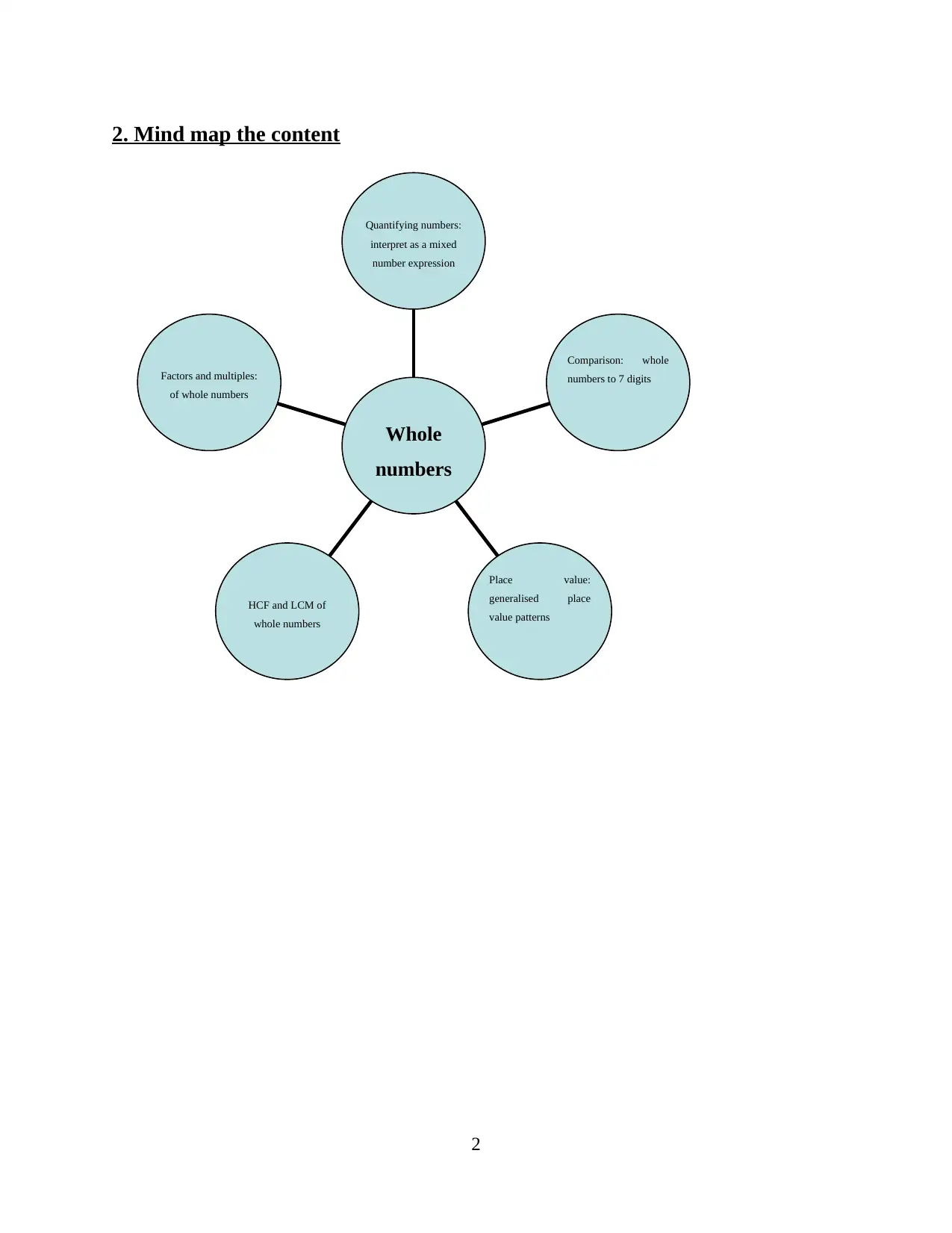
2. Mind map the content
2
Factors and multiples:
of whole numbers
HCF and LCM of
whole numbers
Place value:
generalised place
value patterns
Comparison: whole
numbers to 7 digits
Quantifying numbers:
interpret as a mixed
number expression
Whole
numbers
2
Factors and multiples:
of whole numbers
HCF and LCM of
whole numbers
Place value:
generalised place
value patterns
Comparison: whole
numbers to 7 digits
Quantifying numbers:
interpret as a mixed
number expression
Whole
numbers
Paraphrase This Document
Need a fresh take? Get an instant paraphrase of this document with our AI Paraphraser
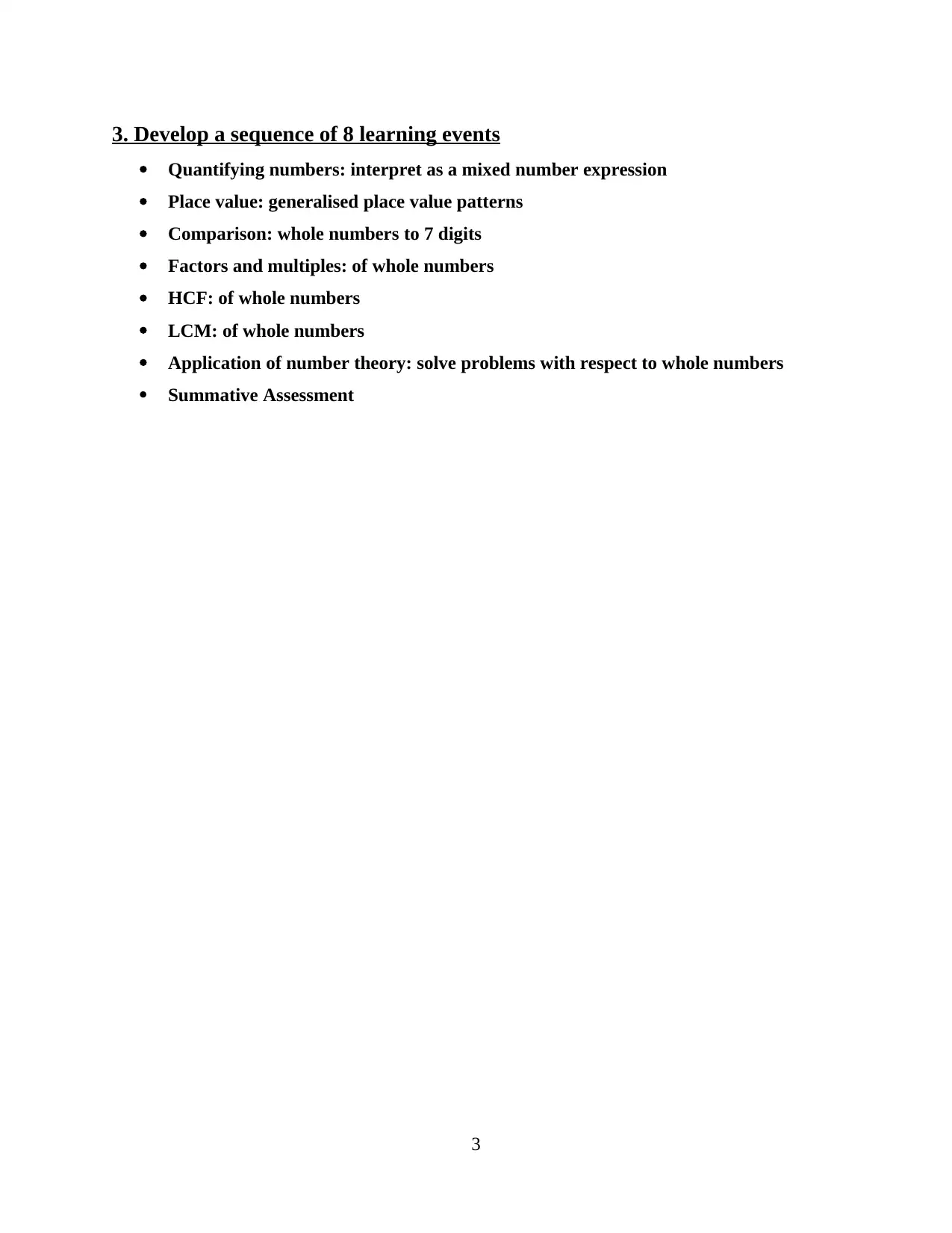
3. Develop a sequence of 8 learning events
Quantifying numbers: interpret as a mixed number expression
Place value: generalised place value patterns
Comparison: whole numbers to 7 digits
Factors and multiples: of whole numbers
HCF: of whole numbers
LCM: of whole numbers
Application of number theory: solve problems with respect to whole numbers
Summative Assessment
3
Quantifying numbers: interpret as a mixed number expression
Place value: generalised place value patterns
Comparison: whole numbers to 7 digits
Factors and multiples: of whole numbers
HCF: of whole numbers
LCM: of whole numbers
Application of number theory: solve problems with respect to whole numbers
Summative Assessment
3
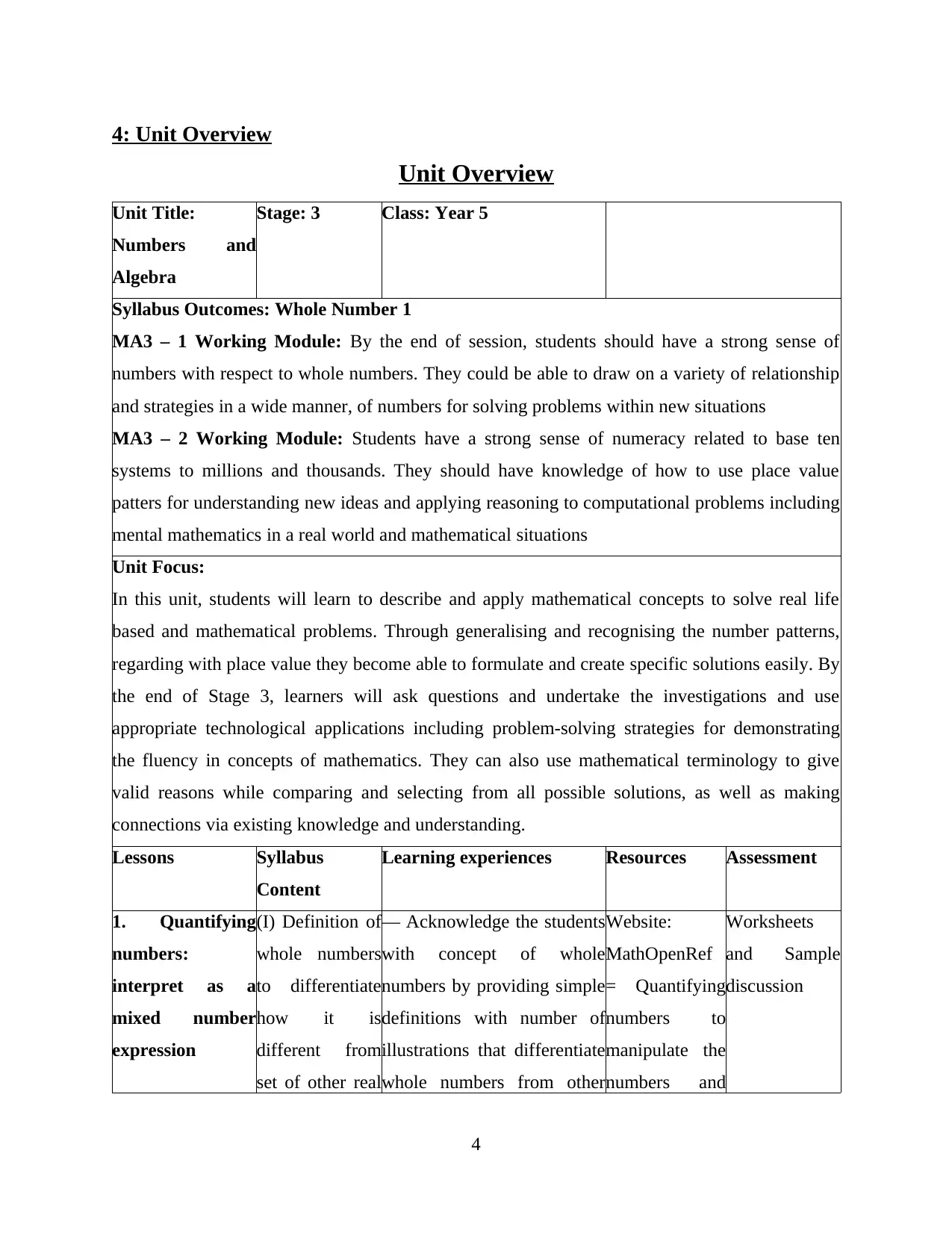
4: Unit Overview
Unit Overview
Unit Title:
Numbers and
Algebra
Stage: 3 Class: Year 5
Syllabus Outcomes: Whole Number 1
MA3 – 1 Working Module: By the end of session, students should have a strong sense of
numbers with respect to whole numbers. They could be able to draw on a variety of relationship
and strategies in a wide manner, of numbers for solving problems within new situations
MA3 – 2 Working Module: Students have a strong sense of numeracy related to base ten
systems to millions and thousands. They should have knowledge of how to use place value
patters for understanding new ideas and applying reasoning to computational problems including
mental mathematics in a real world and mathematical situations
Unit Focus:
In this unit, students will learn to describe and apply mathematical concepts to solve real life
based and mathematical problems. Through generalising and recognising the number patterns,
regarding with place value they become able to formulate and create specific solutions easily. By
the end of Stage 3, learners will ask questions and undertake the investigations and use
appropriate technological applications including problem-solving strategies for demonstrating
the fluency in concepts of mathematics. They can also use mathematical terminology to give
valid reasons while comparing and selecting from all possible solutions, as well as making
connections via existing knowledge and understanding.
Lessons Syllabus
Content
Learning experiences Resources Assessment
1. Quantifying
numbers:
interpret as a
mixed number
expression
(I) Definition of
whole numbers
to differentiate
how it is
different from
set of other real
― Acknowledge the students
with concept of whole
numbers by providing simple
definitions with number of
illustrations that differentiate
whole numbers from other
Website:
MathOpenRef
= Quantifying
numbers to
manipulate the
numbers and
Worksheets
and Sample
discussion
4
Unit Overview
Unit Title:
Numbers and
Algebra
Stage: 3 Class: Year 5
Syllabus Outcomes: Whole Number 1
MA3 – 1 Working Module: By the end of session, students should have a strong sense of
numbers with respect to whole numbers. They could be able to draw on a variety of relationship
and strategies in a wide manner, of numbers for solving problems within new situations
MA3 – 2 Working Module: Students have a strong sense of numeracy related to base ten
systems to millions and thousands. They should have knowledge of how to use place value
patters for understanding new ideas and applying reasoning to computational problems including
mental mathematics in a real world and mathematical situations
Unit Focus:
In this unit, students will learn to describe and apply mathematical concepts to solve real life
based and mathematical problems. Through generalising and recognising the number patterns,
regarding with place value they become able to formulate and create specific solutions easily. By
the end of Stage 3, learners will ask questions and undertake the investigations and use
appropriate technological applications including problem-solving strategies for demonstrating
the fluency in concepts of mathematics. They can also use mathematical terminology to give
valid reasons while comparing and selecting from all possible solutions, as well as making
connections via existing knowledge and understanding.
Lessons Syllabus
Content
Learning experiences Resources Assessment
1. Quantifying
numbers:
interpret as a
mixed number
expression
(I) Definition of
whole numbers
to differentiate
how it is
different from
set of other real
― Acknowledge the students
with concept of whole
numbers by providing simple
definitions with number of
illustrations that differentiate
whole numbers from other
Website:
MathOpenRef
= Quantifying
numbers to
manipulate the
numbers and
Worksheets
and Sample
discussion
4
⊘ This is a preview!⊘
Do you want full access?
Subscribe today to unlock all pages.

Trusted by 1+ million students worldwide
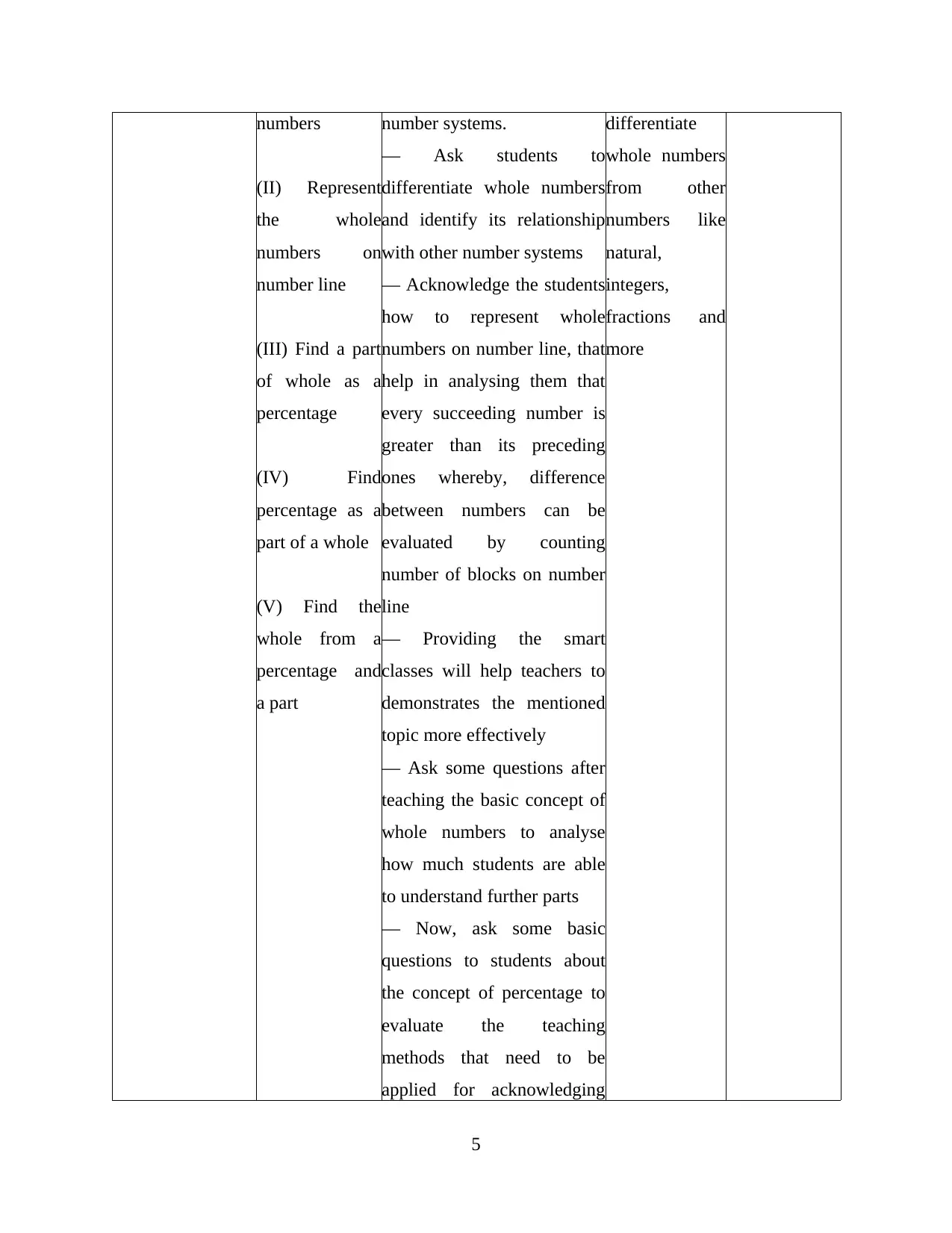
numbers
(II) Represent
the whole
numbers on
number line
(III) Find a part
of whole as a
percentage
(IV) Find
percentage as a
part of a whole
(V) Find the
whole from a
percentage and
a part
number systems.
― Ask students to
differentiate whole numbers
and identify its relationship
with other number systems
― Acknowledge the students
how to represent whole
numbers on number line, that
help in analysing them that
every succeeding number is
greater than its preceding
ones whereby, difference
between numbers can be
evaluated by counting
number of blocks on number
line
― Providing the smart
classes will help teachers to
demonstrates the mentioned
topic more effectively
― Ask some questions after
teaching the basic concept of
whole numbers to analyse
how much students are able
to understand further parts
― Now, ask some basic
questions to students about
the concept of percentage to
evaluate the teaching
methods that need to be
applied for acknowledging
differentiate
whole numbers
from other
numbers like
natural,
integers,
fractions and
more
5
(II) Represent
the whole
numbers on
number line
(III) Find a part
of whole as a
percentage
(IV) Find
percentage as a
part of a whole
(V) Find the
whole from a
percentage and
a part
number systems.
― Ask students to
differentiate whole numbers
and identify its relationship
with other number systems
― Acknowledge the students
how to represent whole
numbers on number line, that
help in analysing them that
every succeeding number is
greater than its preceding
ones whereby, difference
between numbers can be
evaluated by counting
number of blocks on number
line
― Providing the smart
classes will help teachers to
demonstrates the mentioned
topic more effectively
― Ask some questions after
teaching the basic concept of
whole numbers to analyse
how much students are able
to understand further parts
― Now, ask some basic
questions to students about
the concept of percentage to
evaluate the teaching
methods that need to be
applied for acknowledging
differentiate
whole numbers
from other
numbers like
natural,
integers,
fractions and
more
5
Paraphrase This Document
Need a fresh take? Get an instant paraphrase of this document with our AI Paraphraser
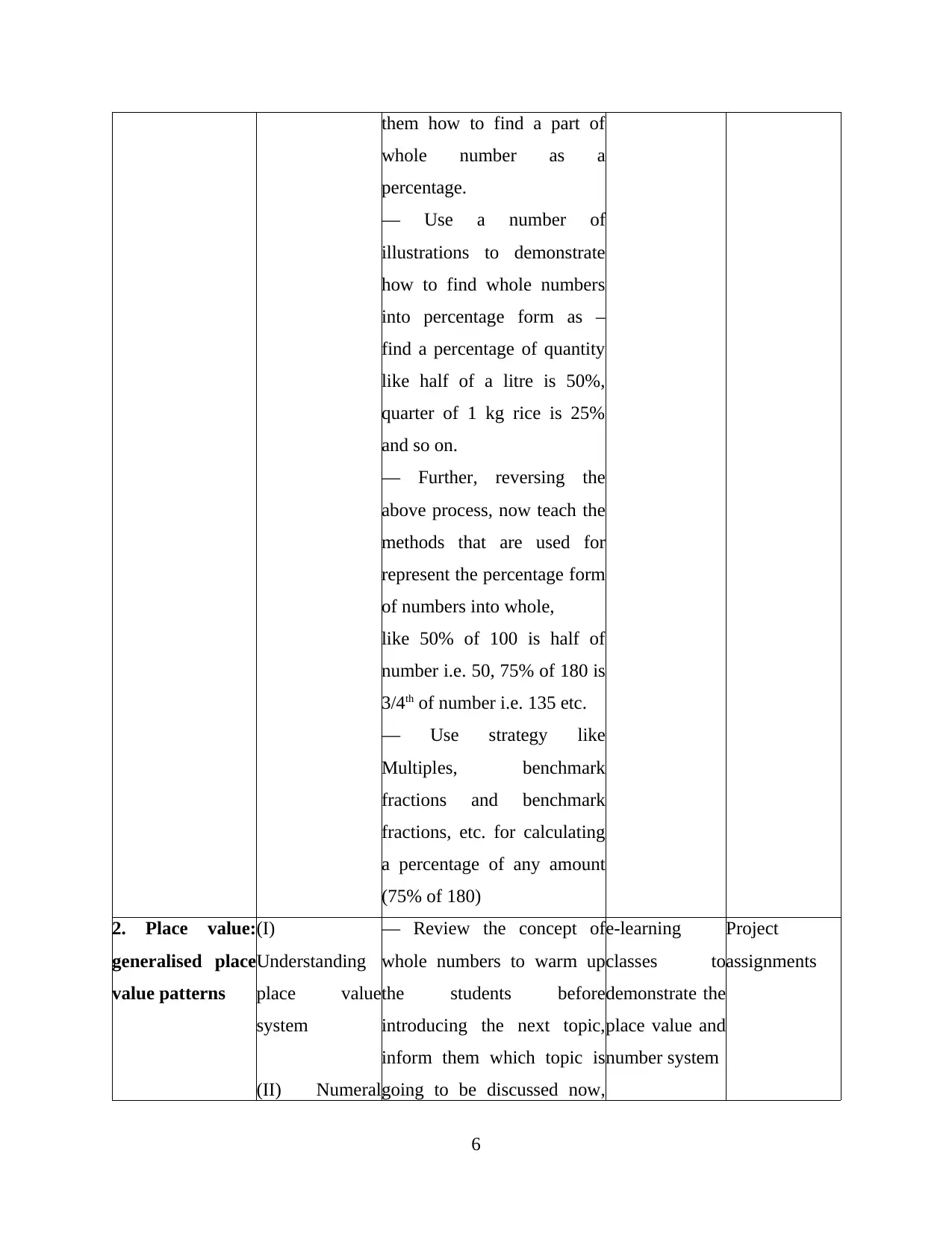
them how to find a part of
whole number as a
percentage.
― Use a number of
illustrations to demonstrate
how to find whole numbers
into percentage form as –
find a percentage of quantity
like half of a litre is 50%,
quarter of 1 kg rice is 25%
and so on.
― Further, reversing the
above process, now teach the
methods that are used for
represent the percentage form
of numbers into whole,
like 50% of 100 is half of
number i.e. 50, 75% of 180 is
3/4th of number i.e. 135 etc.
― Use strategy like
Multiples, benchmark
fractions and benchmark
fractions, etc. for calculating
a percentage of any amount
(75% of 180)
2. Place value:
generalised place
value patterns
(I)
Understanding
place value
system
(II) Numeral
― Review the concept of
whole numbers to warm up
the students before
introducing the next topic,
inform them which topic is
going to be discussed now,
e-learning
classes to
demonstrate the
place value and
number system
Project
assignments
6
whole number as a
percentage.
― Use a number of
illustrations to demonstrate
how to find whole numbers
into percentage form as –
find a percentage of quantity
like half of a litre is 50%,
quarter of 1 kg rice is 25%
and so on.
― Further, reversing the
above process, now teach the
methods that are used for
represent the percentage form
of numbers into whole,
like 50% of 100 is half of
number i.e. 50, 75% of 180 is
3/4th of number i.e. 135 etc.
― Use strategy like
Multiples, benchmark
fractions and benchmark
fractions, etc. for calculating
a percentage of any amount
(75% of 180)
2. Place value:
generalised place
value patterns
(I)
Understanding
place value
system
(II) Numeral
― Review the concept of
whole numbers to warm up
the students before
introducing the next topic,
inform them which topic is
going to be discussed now,
e-learning
classes to
demonstrate the
place value and
number system
Project
assignments
6
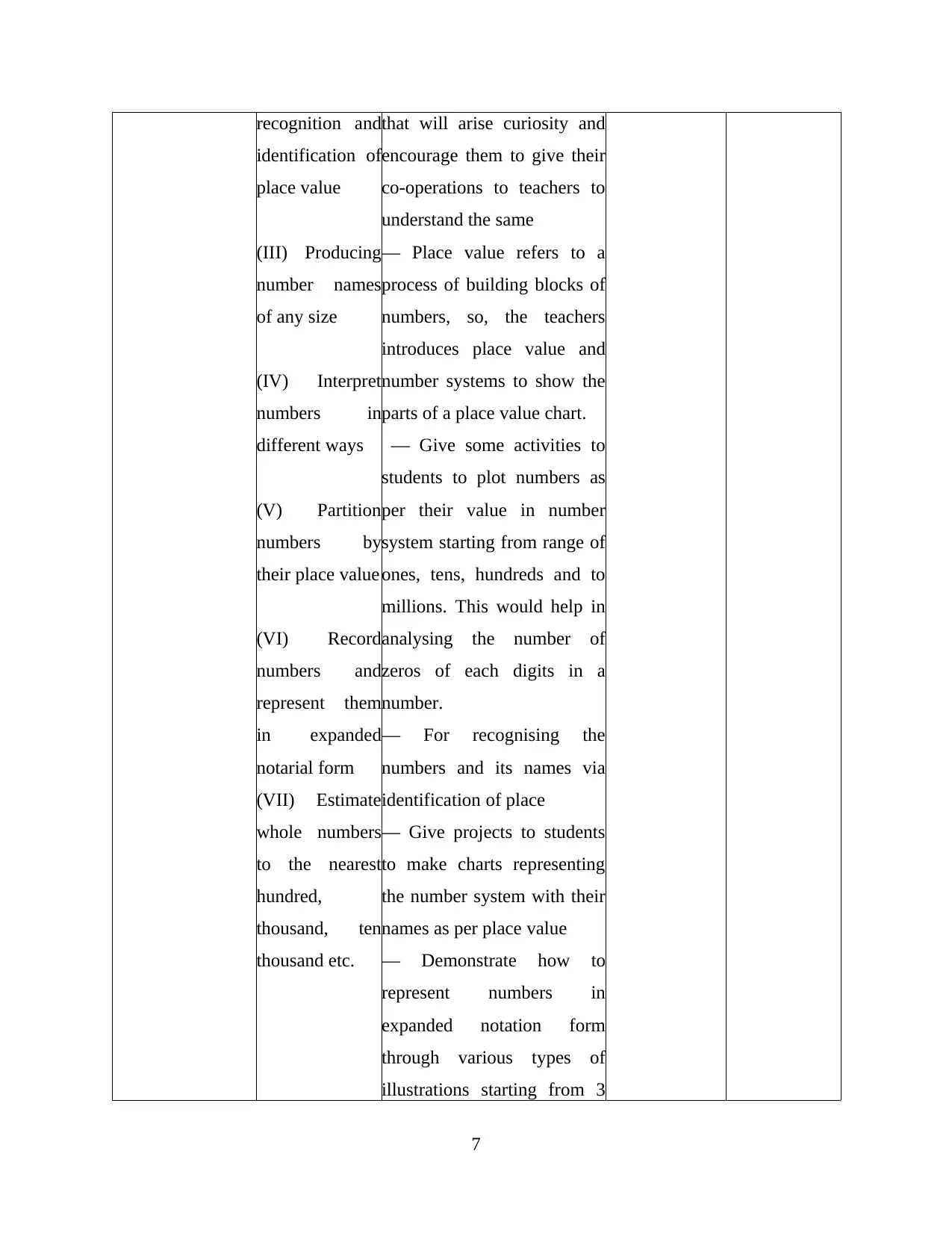
recognition and
identification of
place value
(III) Producing
number names
of any size
(IV) Interpret
numbers in
different ways
(V) Partition
numbers by
their place value
(VI) Record
numbers and
represent them
in expanded
notarial form
(VII) Estimate
whole numbers
to the nearest
hundred,
thousand, ten
thousand etc.
that will arise curiosity and
encourage them to give their
co-operations to teachers to
understand the same
― Place value refers to a
process of building blocks of
numbers, so, the teachers
introduces place value and
number systems to show the
parts of a place value chart.
― Give some activities to
students to plot numbers as
per their value in number
system starting from range of
ones, tens, hundreds and to
millions. This would help in
analysing the number of
zeros of each digits in a
number.
― For recognising the
numbers and its names via
identification of place
― Give projects to students
to make charts representing
the number system with their
names as per place value
― Demonstrate how to
represent numbers in
expanded notation form
through various types of
illustrations starting from 3
7
identification of
place value
(III) Producing
number names
of any size
(IV) Interpret
numbers in
different ways
(V) Partition
numbers by
their place value
(VI) Record
numbers and
represent them
in expanded
notarial form
(VII) Estimate
whole numbers
to the nearest
hundred,
thousand, ten
thousand etc.
that will arise curiosity and
encourage them to give their
co-operations to teachers to
understand the same
― Place value refers to a
process of building blocks of
numbers, so, the teachers
introduces place value and
number systems to show the
parts of a place value chart.
― Give some activities to
students to plot numbers as
per their value in number
system starting from range of
ones, tens, hundreds and to
millions. This would help in
analysing the number of
zeros of each digits in a
number.
― For recognising the
numbers and its names via
identification of place
― Give projects to students
to make charts representing
the number system with their
names as per place value
― Demonstrate how to
represent numbers in
expanded notation form
through various types of
illustrations starting from 3
7
⊘ This is a preview!⊘
Do you want full access?
Subscribe today to unlock all pages.

Trusted by 1+ million students worldwide
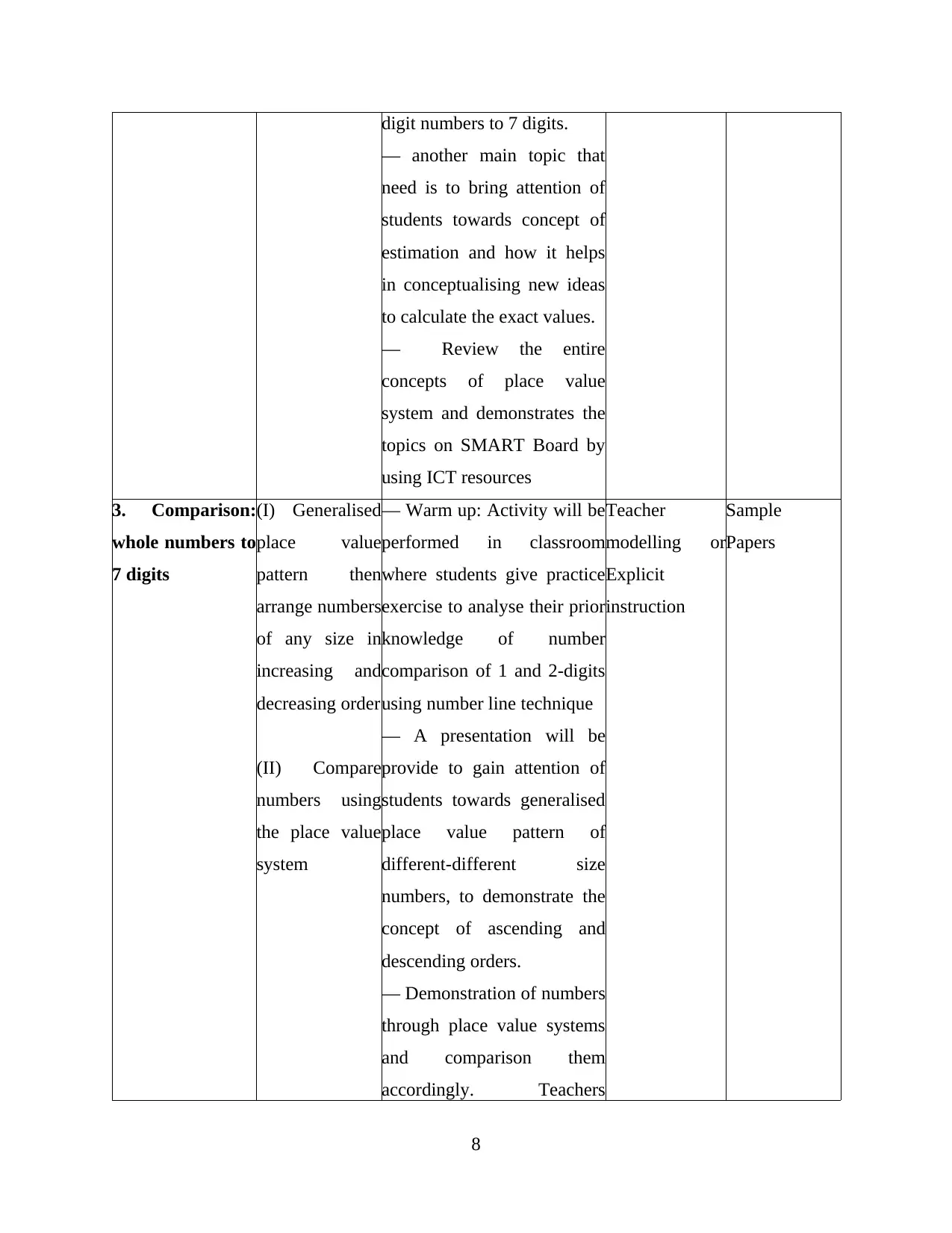
digit numbers to 7 digits.
― another main topic that
need is to bring attention of
students towards concept of
estimation and how it helps
in conceptualising new ideas
to calculate the exact values.
― Review the entire
concepts of place value
system and demonstrates the
topics on SMART Board by
using ICT resources
3. Comparison:
whole numbers to
7 digits
(I) Generalised
place value
pattern then
arrange numbers
of any size in
increasing and
decreasing order
(II) Compare
numbers using
the place value
system
― Warm up: Activity will be
performed in classroom
where students give practice
exercise to analyse their prior
knowledge of number
comparison of 1 and 2-digits
using number line technique
― A presentation will be
provide to gain attention of
students towards generalised
place value pattern of
different-different size
numbers, to demonstrate the
concept of ascending and
descending orders.
― Demonstration of numbers
through place value systems
and comparison them
accordingly. Teachers
Teacher
modelling or
Explicit
instruction
Sample
Papers
8
― another main topic that
need is to bring attention of
students towards concept of
estimation and how it helps
in conceptualising new ideas
to calculate the exact values.
― Review the entire
concepts of place value
system and demonstrates the
topics on SMART Board by
using ICT resources
3. Comparison:
whole numbers to
7 digits
(I) Generalised
place value
pattern then
arrange numbers
of any size in
increasing and
decreasing order
(II) Compare
numbers using
the place value
system
― Warm up: Activity will be
performed in classroom
where students give practice
exercise to analyse their prior
knowledge of number
comparison of 1 and 2-digits
using number line technique
― A presentation will be
provide to gain attention of
students towards generalised
place value pattern of
different-different size
numbers, to demonstrate the
concept of ascending and
descending orders.
― Demonstration of numbers
through place value systems
and comparison them
accordingly. Teachers
Teacher
modelling or
Explicit
instruction
Sample
Papers
8
Paraphrase This Document
Need a fresh take? Get an instant paraphrase of this document with our AI Paraphraser
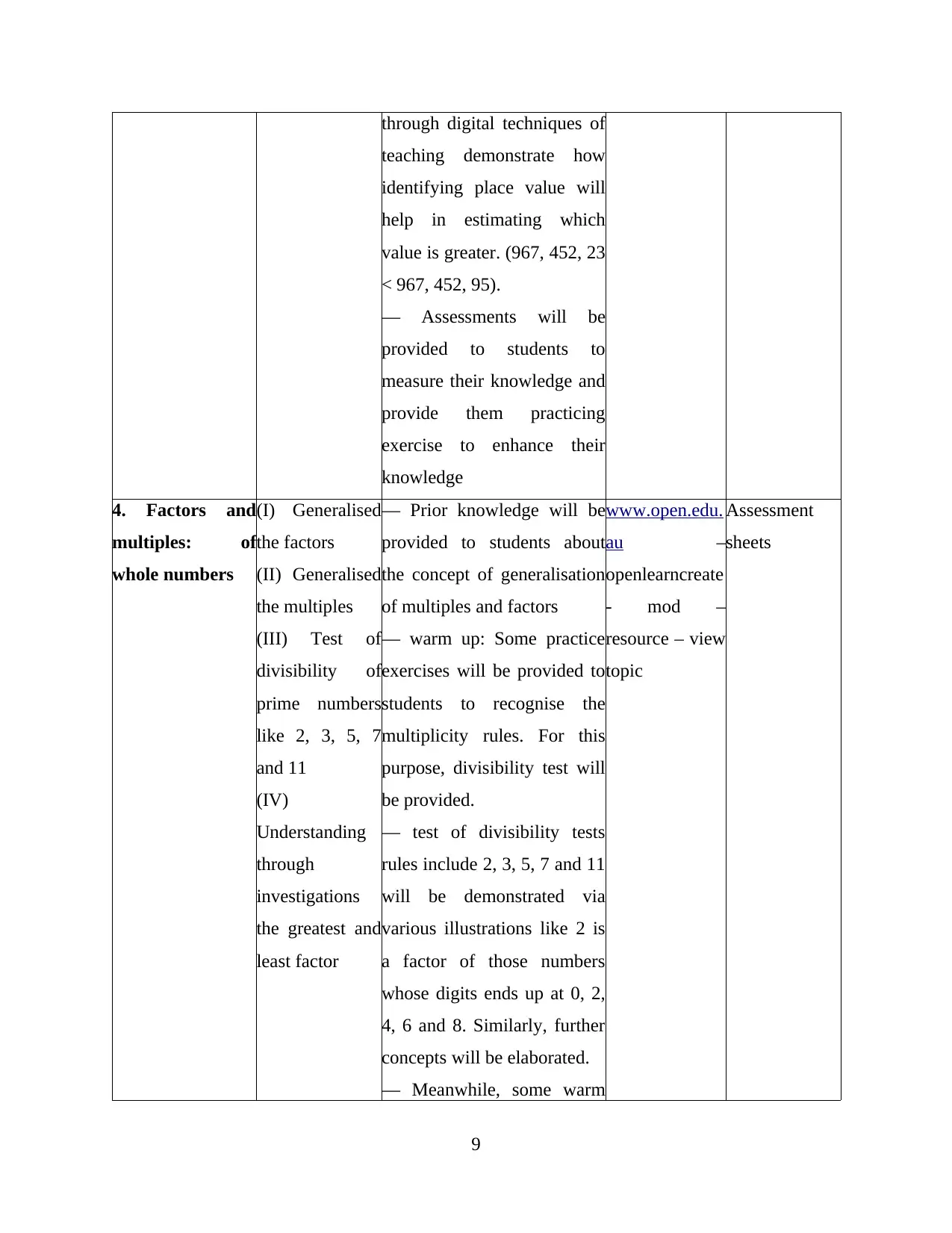
through digital techniques of
teaching demonstrate how
identifying place value will
help in estimating which
value is greater. (967, 452, 23
< 967, 452, 95).
― Assessments will be
provided to students to
measure their knowledge and
provide them practicing
exercise to enhance their
knowledge
4. Factors and
multiples: of
whole numbers
(I) Generalised
the factors
(II) Generalised
the multiples
(III) Test of
divisibility of
prime numbers
like 2, 3, 5, 7
and 11
(IV)
Understanding
through
investigations
the greatest and
least factor
― Prior knowledge will be
provided to students about
the concept of generalisation
of multiples and factors
― warm up: Some practice
exercises will be provided to
students to recognise the
multiplicity rules. For this
purpose, divisibility test will
be provided.
― test of divisibility tests
rules include 2, 3, 5, 7 and 11
will be demonstrated via
various illustrations like 2 is
a factor of those numbers
whose digits ends up at 0, 2,
4, 6 and 8. Similarly, further
concepts will be elaborated.
― Meanwhile, some warm
www.open.edu.
au –
openlearncreate
- mod –
resource – view
topic
Assessment
sheets
9
teaching demonstrate how
identifying place value will
help in estimating which
value is greater. (967, 452, 23
< 967, 452, 95).
― Assessments will be
provided to students to
measure their knowledge and
provide them practicing
exercise to enhance their
knowledge
4. Factors and
multiples: of
whole numbers
(I) Generalised
the factors
(II) Generalised
the multiples
(III) Test of
divisibility of
prime numbers
like 2, 3, 5, 7
and 11
(IV)
Understanding
through
investigations
the greatest and
least factor
― Prior knowledge will be
provided to students about
the concept of generalisation
of multiples and factors
― warm up: Some practice
exercises will be provided to
students to recognise the
multiplicity rules. For this
purpose, divisibility test will
be provided.
― test of divisibility tests
rules include 2, 3, 5, 7 and 11
will be demonstrated via
various illustrations like 2 is
a factor of those numbers
whose digits ends up at 0, 2,
4, 6 and 8. Similarly, further
concepts will be elaborated.
― Meanwhile, some warm
www.open.edu.
au –
openlearncreate
- mod –
resource – view
topic
Assessment
sheets
9
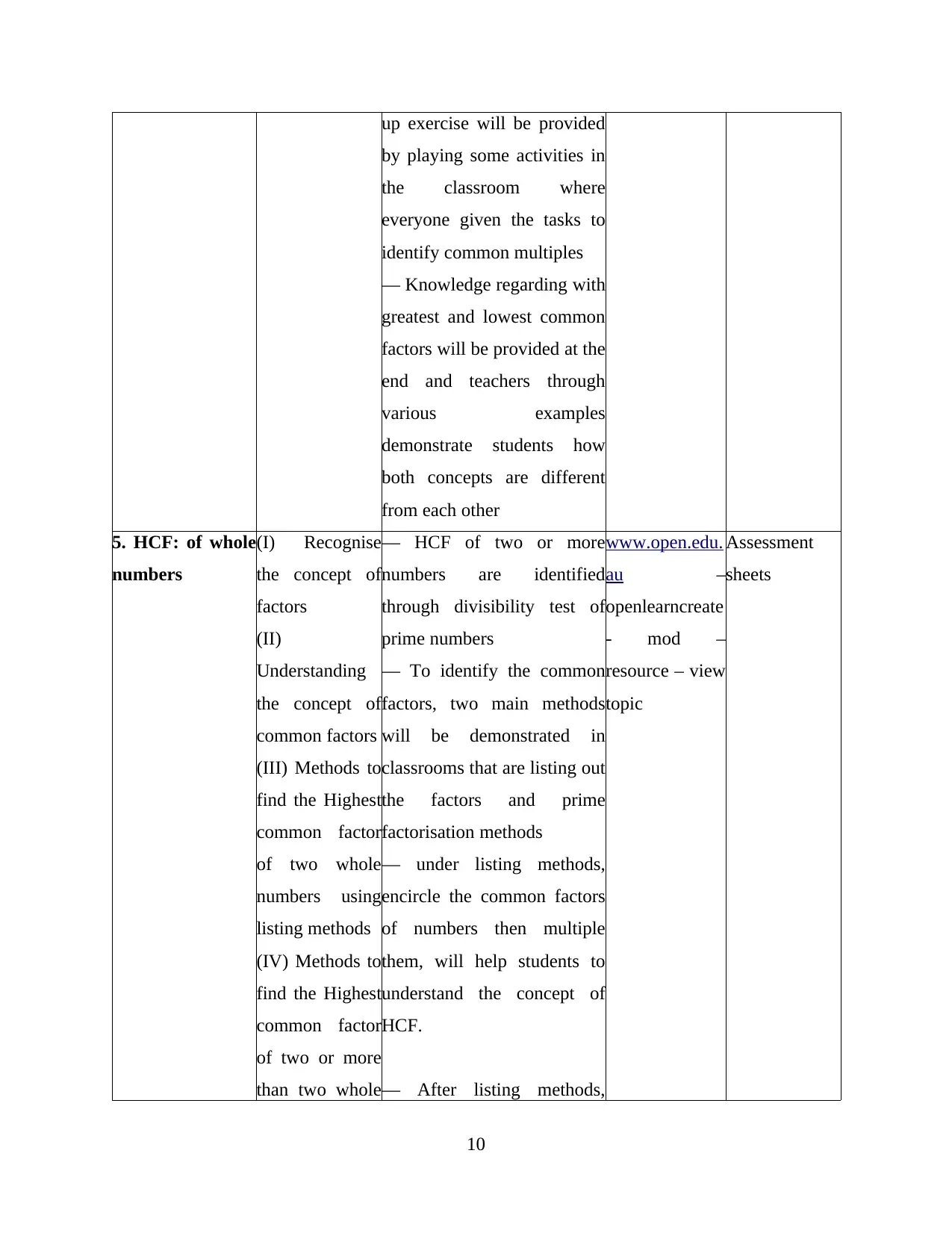
up exercise will be provided
by playing some activities in
the classroom where
everyone given the tasks to
identify common multiples
― Knowledge regarding with
greatest and lowest common
factors will be provided at the
end and teachers through
various examples
demonstrate students how
both concepts are different
from each other
5. HCF: of whole
numbers
(I) Recognise
the concept of
factors
(II)
Understanding
the concept of
common factors
(III) Methods to
find the Highest
common factor
of two whole
numbers using
listing methods
(IV) Methods to
find the Highest
common factor
of two or more
than two whole
― HCF of two or more
numbers are identified
through divisibility test of
prime numbers
― To identify the common
factors, two main methods
will be demonstrated in
classrooms that are listing out
the factors and prime
factorisation methods
― under listing methods,
encircle the common factors
of numbers then multiple
them, will help students to
understand the concept of
HCF.
― After listing methods,
www.open.edu.
au –
openlearncreate
- mod –
resource – view
topic
Assessment
sheets
10
by playing some activities in
the classroom where
everyone given the tasks to
identify common multiples
― Knowledge regarding with
greatest and lowest common
factors will be provided at the
end and teachers through
various examples
demonstrate students how
both concepts are different
from each other
5. HCF: of whole
numbers
(I) Recognise
the concept of
factors
(II)
Understanding
the concept of
common factors
(III) Methods to
find the Highest
common factor
of two whole
numbers using
listing methods
(IV) Methods to
find the Highest
common factor
of two or more
than two whole
― HCF of two or more
numbers are identified
through divisibility test of
prime numbers
― To identify the common
factors, two main methods
will be demonstrated in
classrooms that are listing out
the factors and prime
factorisation methods
― under listing methods,
encircle the common factors
of numbers then multiple
them, will help students to
understand the concept of
HCF.
― After listing methods,
www.open.edu.
au –
openlearncreate
- mod –
resource – view
topic
Assessment
sheets
10
⊘ This is a preview!⊘
Do you want full access?
Subscribe today to unlock all pages.

Trusted by 1+ million students worldwide
1 out of 23
Your All-in-One AI-Powered Toolkit for Academic Success.
+13062052269
info@desklib.com
Available 24*7 on WhatsApp / Email
![[object Object]](/_next/static/media/star-bottom.7253800d.svg)
Unlock your academic potential
Copyright © 2020–2025 A2Z Services. All Rights Reserved. Developed and managed by ZUCOL.


